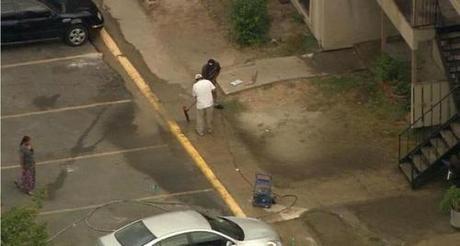
Thomas Eric Duncan (from a Facebook photo)
Ebola is a virus that has a 60-90% fatality. There is no cure.
Thomas Eric Duncan, 42, a Liberian national who recently flew from Nigeria, arriving in Dallas, Texas on September 20, 2014, is the first diagnosed case of Ebola in the United States.
Both Liberia and Nigeria are among the West African countries stricken by the terrible epidemic that has a 60-90% fatality rate. (See “First case of Ebola in U.S. may have contacted 18, incl. 5 children, while showing symptoms“)
On Sept. 26, four days after he arrived in Dallas, Duncan displayed the early flu-like symptoms of Ebola — of fever, sore throat, headache and muscle pain. He sought treatment at a hospital but was sent home.
By Sunday, Sept. 28, he had worsened — sweating profusely and had diarrhea. He finally was hospitalized and is being kept in isolation at Texas Health Presbyterian Hospital of Dallas.
Two days later on Sept. 30, lab results on tests done on Duncan confirmed he has Ebola.
On Sunday, as he was taken away to the hospital in an ambulance, Duncan vomited in the parking lot outside The Ivy, an apartment complex in the Vickery Meadow neighborhood north of downtown Dallas where he had been staying. As reported by Yahoo:
His whole family was screaming. He got outside and he was throwing up all over the place,” resident Mesud Osmanovic, 21, said . . . describing the chaotic scene before the man was admitted to Texas Health Presbyterian Hospital on Sunday where he is in serious condition
The New York Times reports that Texas state and local authorities confirmed today (Oct. 2) that a week after Duncan had fallen ill with Ebola in Dallas, and four days after he was placed in isolation at a hospital here, the apartment where he was staying with four other people still had not been sanitized and the sheets and dirty towels he used while sick remained in the home. County officials visited the apartment without protection Wednesday night.
Hospitals say they face a major challenge disposing of waste generated in the care of Ebola patients because two federal agencies have issued conflicting guidance on what they should do. As a result, hospitals say, waste may pile up, and they cannot get rid of it.
The delay in cleaning Duncan’s apartment came amid reports that as many as 100 people could have had contact with him. In a news conference this afternoon, Thomas R. Frieden, the director of the Centers for Disease Control and Prevention, said that health workers were assessing 100 people — including hospital workers and emergency medical technicians — to determine whether they had been exposed. That number does not include secondary contacts — those who had contact with people who had direct contact with Duncan, such as his family members.
Duncan’s four family members are now quarantined inside the apartment. Police cars were stationed at the complex Thursday, to keep reporters out and the family in. Officials said they were arranging to have food and other necessities delivered to the apartment.
Those who are discovered to have had direct contact with Duncan will be monitored for three weeks, receiving twice-a-day visits from health officials who will take their temperature and inquire about other symptoms.
Remember Duncan’s vomit in the parking lot of The Ivy?
Chopper 5 from WFAA Channel 8 in Dallas took aerial footage of two workers cleaning up the vomit. This image from the aerial footage has gone viral on Twitter (source: Twitchy):

We are told that the Ebola virus is transmitted via direct contact with blood or bodily fluids from an infected person (including embalming of an infected dead person) or by contact with objects contaminated by the virus, particularly needles and syringes. But a Canadian research study in 2012 had shown that in the laboratory, Ebola was transmitted via air from one animal species (pigs) to another (primates).
The Ebola virus can be eliminated with heat (heating for 30 to 60 minutes at 60 °C or boiling for 5 minutes). On surfaces, some lipid solvents such as some alcohol-based products, detergents, sodium hypochlorite (bleach) or calcium hypochlorite (bleaching powder), and other suitable disinfectants at appropriate concentrations can be used as disinfectants. (Source: Wikipedia)
Notice the workers cleaning up Duncan’s vomit weren’t wearing surgical masks or protective hazmat suits.
Notice the workers appear to be using a power hose to wash off the vomit, which would only blast the vomit into the air in the form of tiny particles and droplets, all the better for aerial transmission.
Nor do we know how long the vomit was on the pavement and whether any dog or other animal had ingested the vomit.
Note that all this inexcusable sloppiness and carelessness is happening in 21st century America, not in backward Liberia or Sierra Leone in West Africa.
Frightening.
H/t FOTM’s DCG
~Eowyn

